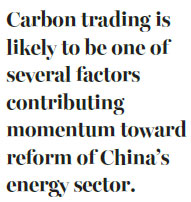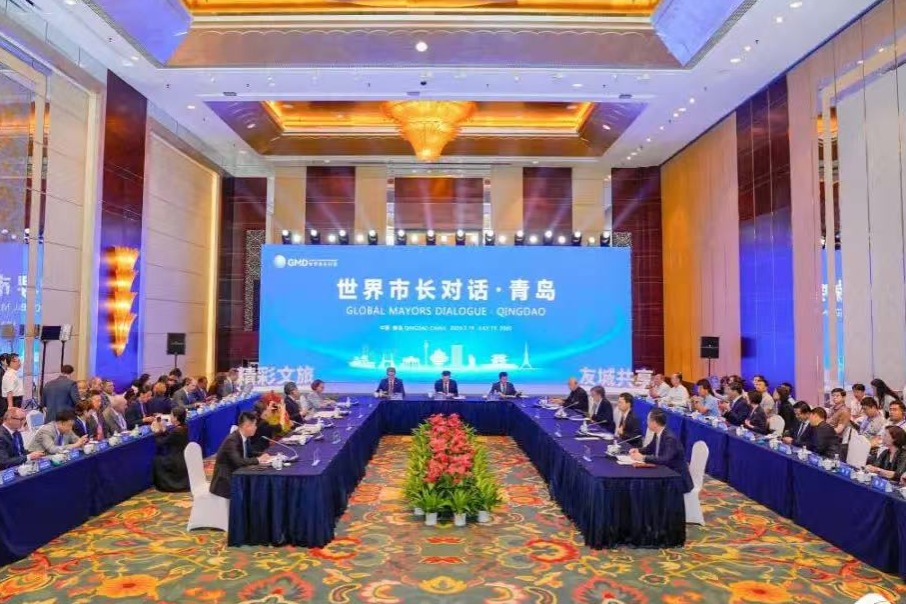Carbon trading can boost momentum

China's energy sector reform demands that government, the private sector and other stakeholders continue strong efforts
Trading carbon emissions rights is a key market-based tool to achieve China's targets of reducing carbon emission intensity of GDP by 40 to 45 percent by 2020 from 2005 levels, and 60 to 65 percent by 2030. In 2013-14, pilot emissions trading systems were initiated in seven regions around the country and, in 2015, the government committed to introducing a national ETS by the end of 2017. A key rationale for an ETS is to provide a price signal throughout the economy to reduce carbon.
This market-based approach of emissions trading can be in conflict with a partially marketized power sector, which accounts for about half of China's energy-related carbon emissions.
Electricity prices, which are set by the National Development and Reform Commission's Department of Price Supervision, have a limited capacity to reflect the additional carbon price. The NDRC has been reluctant to increase electricity prices for households due to the potential economic impact on poor people, leading to falling prices in real terms.
Since early last year, the central government has accelerated efforts to reform electricity pricing, including encouraging generators and large industrial and commercial end-users to negotiate volumes and prices directly, bypassing grid operators. This introduces an element of market competition, but has the potential downside of reducing costs for heavy industries that already have overcapacity, such as aluminum and steel. The government has been attempting to restrict energy-inefficient companies from taking advantage of this reform.
Incorporating the carbon price into electricity prices, however, would be a more effective way to achieve emissions reduction at the lowest cost. Without effective electricity price reform, therefore, the ETS will be less effective.

Some provinces have committed to introduce market-based bidding in the coming years, which should allow renewable energy to compete favorably with coal power operators at times of high supply. Whether these new market-based pricing mechanisms will allow for carbon cost pass-through is an open question. Given existing overcapacity in the power sector, increasing competitiveness may mean that generators are forced to keep prices down as much as possible to secure contracts and compete on spot markets.
Carbon pricing inevitably gives rise to debates about competitiveness, and China is no different. Large State-owned enterprises advocate a principle of "no additional cost pressure" for the power sector because of emissions trading, reflecting legitimate concerns regarding their limited capacity to pass on higher costs to their consumers. Most pilot regions granted free permits to 100 percent of companies' carbon use at the beginning of the process.
However, data shows that electricity price increases would be small. The Guangdong pilot region estimated that costs would increase by 0.003 yuan/kWh, given 1 to 3 percent under-allocation of permits and assuming a high price of 100 yuan ($14.8; 12.8 euros; £11.4) per ton of carbon emissions. Since the industry operates in an environment where input costs, especially coal prices, can fluctuate by up to 60 percent within one year, the added impact of a carbon price in this case would be extremely marginal. In addition, another study found that even if up to 10 percent of allowances were withheld for auction, costs would increase by 0.7 percent under a more realistic price of 40 yuan per ton.
The NDRC has indicated that the share of allowances allocated free should fall over time, with the remainder sold at auction.
Each of the "big five" power generators has a carbon assets division that has experience in managing clean energy projects. Possibly, income from offsets may help to cross-subsidize cost impacts on the coal power generation section of the company. And, this may encourage the NDRC to allow a relatively larger cost impact on these companies than for smaller enterprises.
According to national allocation plans that were released for discussion at a training workshop in Sichuan in May, permit allocation in the power sector will incorporate varying benchmarks for different levels of generator efficiency. They range from 807 kilograms of CO2 per megawatt hour for large ultra-supercritical (high efficiency) coal power stations, to 1,018 kg CO2/mWh for subcritical (low efficiency) units below 300mW. The less stringent standard set for small plants will limit costs for those companies but the NDRC needs to balance the demands of small power generators with the program's overall effectiveness.
The national emission trading system provides an opportunity for carbon pricing to help facilitate a market adjustment to more efficient power plants. In Shanxi and Henan, for example, there is both significant subcritical coal power capacity, and average utilization rates are down to 44 percent (from almost 60 percent in 2010). This is because significant new capacity has been added in recent years, while demand for electricity has not grown as quickly as expected. Permit allocation in these areas of severe overcapacity could afford to be stricter than in areas where demand is still high.
Ultimately, carbon trading is likely to be one of several factors contributing momentum toward reform of China's energy sector, and, ultimately, to emissions reduction. The pace of reform has quickened in the past two years, and China's ambitious low-carbon development agenda demands that all levels of government, the private sector and other stakeholders continue to push to ensure that China's carbon trading experiment is a success.
The author is research manager at the China Carbon Forum. The views do not necessarily reflect those of China Daily.
(China Daily European Weekly 07/21/2017 page9)
Today's Top News
- Mayors from around the world gather in Qingdao for dialogue
- Premier announces construction of Yarlung Zangbo hydropower project
- Digital countryside fueling reverse urbanization
- 'Sky Eye' helps unlock mysteries of the universe
- China offers LAC development dividend
- Future sectors to receive more play






























